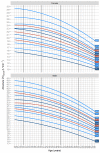Reference values for peak oxygen uptake: cross-sectional analysis of cycle ergometry-based cardiopulmonary exercise tests of 10 090 adult German volunteers from the Prevention First Registry
- PMID: 29506981
- PMCID: PMC5855221
- DOI: 10.1136/bmjopen-2017-018697
Reference values for peak oxygen uptake: cross-sectional analysis of cycle ergometry-based cardiopulmonary exercise tests of 10 090 adult German volunteers from the Prevention First Registry
Abstract
Objective: This study aims to construct quantile reference values for peak oxygen uptake (V̇O2peak) measured by cycle ergometry-based incremental cardiopulmonary exercise tests.
Design: Cross-sectional study using quantile regressions to fit sex-specific and age-specific quantile curves. Exercise tests were conducted using cycle ergometry. Maximal effort in the exercise tests wass assumed when respiratory exchange ratio ≥1.1 or lactate ≥8 mmol/L or maximal heart rate ≥90% of the age-predicted maximal heart rate. This was assessed retrospectively for a random subsample with an a priori calculated sample size of n=252 participants.
Setting: A network of private outpatient clinics in three German cities recorded the results of cycle ergometry-based cardiopulmonary exercise tests to a central database (Prevention First Registry) from 2001 to 2015.
Participants: 10 090 participants (6462 men, 3628 women) from more than 100 local companies volunteered in workplace health promotion programmes. Participants were aged 21 to 83 years, were free of acute complaints and had primarily sedentary working environments.
Main outcome measure: Peak oxygen uptake was measured as absolute V̇O2peak in litres of oxygen per minute and relative V̇O2peak in millilitres of oxygen per kilogram of body mass per minute.
Results: The mean age for both men and women was 46 years. Median relative V̇O2peak was 36 and 30 mL/kg/min at 40 to 49 years, as well as 32 and 26 mL/kg/min at 50 to 59 years for men and women, respectively. An estimated proportion of 97% of the participants performed the exercise test until exertion.
Conclusions: Reference values and nomograms for V̇O2peak were derived from a large sample of preventive healthcare examinations of healthy white-collar workers. The presented results can be applied to participants of exercise tests using cycle ergometry who are part of a population that is comparable to this study.
Keywords: Vo2peak; exercise test; peak oxygen uptake; physical fitness; reference values.
© Article author(s) (or their employer(s) unless otherwise stated in the text of the article) 2018. All rights reserved. No commercial use is permitted unless otherwise expressly granted.
Conflict of interest statement
Competing interests: None declared.
Figures





References
MeSH terms
Substances
LinkOut - more resources
Full Text Sources
Other Literature Sources
Medical
